Yogi Ramaiah
B.V.Narasimha Swami was the first English biographer of Sri Ramana Maharshi. He asked many devotees and disciples to write about their lives and experiences with the Master. Yogi Ramiah submitted a 2000 word essay, from which B.V.N. extracted a short edited account to print in his book, titled Self-Realization.
The following is B.V.Narasimha Swami's edited account published in Self Realization, followed by the full autobiographical essay written by the Yogi himself. All this text has been printed in Arunachala's Ramana, Boundless Ocean of Grace, Book II, published by Sri Ramanasramam and available at the Ashram Bookstall in Tiruvannamalai.
Yogi Ramiah belongs to the community of Reddiars and was a wealthy land proprietor of Annareddipalayam, near Buchi Reddipalayam, Nellore District. He received hardly any education. Being the sole owner of his properties he had every inducement to pass his days merrily with his thoughtless companions, boys of his own age. But at about the age of eighteen his thoughts took a serious turn and he gave up his former associates and took an interest in religion.
A Brahmin Guru imparted to him the Rama Taraka Mantram and asked him to repeat it five thousand times daily. "If the number is exceeded, what then?" asked the ardent youth.
"So much the better," was the Guru's reply.
"If I repeat it always?" was the next query. The Guru was delighted at the keenness of the disciple's enthusiasm and expressed warm approval.
Ramiah went on with his japam from morning till night, whatever he might be doing. He also began to practice pranayanam, breath control. Consequently, vairagya, or disgust with his worldly surroundings, grew so strong in his breast that he suddenly left home to go north to perform tapas in holy places like Kasi, etc.
On the way, he met his Guru who asked him if he had obtained his mother's permission for the pilgrimage. When he admitted that there was no intimation or permission, the Guru sent him back to Annareddipalayam, telling him to "Go and do your tapas in the seclusion of your garden and later on I shall come and see how you have progressed." Ramiah returned home and went on with his tapas. He developed both breath control and meditation without any one to help him. He was able to remain several hours in a blissful mood, beholding the tip of his nose, i.e, breath being easily regulated and stilled. His mind was equally stilled and happy. Perfect continence, sattvic food, just barely enough to keep the body and mind working, and intense devotion through his japa to God (Rama) carried him soon to illumination in samadhi. He noted with surprise how God Rama as an external being vanished and gave place to the feeling of God in the Self. Again he noted that though at the outset he retained the distinction between himself (the subject) and the objects he perceived or thought of, the distinction was dissolved as soon as he was lost in Samadhi, when he experienced no real difference between subject and object.
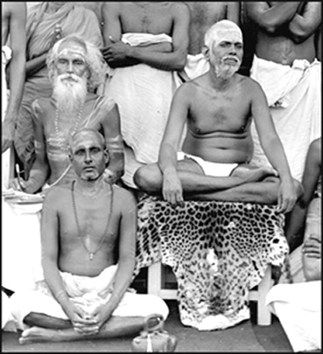 "Could the two be after all identical?" was the thought that occurred to him. As it was a novel and puzzling experience, he did not feel sure of his conclusions and asked local pundits about it. Their replies did not satisfy him. So he came to Tiruvannamalai in 1925 and in Maharshi's presence asked Kavyakantha Ganapathi Śāstṛi
about it. "The subject is of course different from the object," was the Śāstṛi's reply. Ramiah was disappointed and looked up to the Maharshi, who at once supplemented or corrected the Śāstṛi's reply: "Subject and object are distinct in the phenomenal world to the ordinary man, but in samadhi they merge and become one." Ramiah was very glad to note this corroboration from this eminent Swami. Thence forward he took Maharshi as his sole guide.
"Could the two be after all identical?" was the thought that occurred to him. As it was a novel and puzzling experience, he did not feel sure of his conclusions and asked local pundits about it. Their replies did not satisfy him. So he came to Tiruvannamalai in 1925 and in Maharshi's presence asked Kavyakantha Ganapathi Śāstṛi
about it. "The subject is of course different from the object," was the Śāstṛi's reply. Ramiah was disappointed and looked up to the Maharshi, who at once supplemented or corrected the Śāstṛi's reply: "Subject and object are distinct in the phenomenal world to the ordinary man, but in samadhi they merge and become one." Ramiah was very glad to note this corroboration from this eminent Swami. Thence forward he took Maharshi as his sole guide.
For many years he still continued with his life of yoga, with mounam (silence) and tapas, as its support. He ate little, controlled his breath and stayed many hours at a stretch in blissful ecstasy, mostly in the cottage of his own garden. He would also stay for a few months each year with Maharshi at Ramanasramam. He loved and was loved by the Maharshi. As Yogi Ramiah did not know Tamiḷ, the Maharshi translated his Tamiḷ poems "Upadesa Saram" and "Ulladu Narpadu" into Telugu. In appreciation, Yogi Ramiah helped in repairing Palithirtam, in the construction of Asramam hall and the Asramam well.
The original manuscript, wherein Yogi Ramiah tells in his own words about his life and experiences:
From my boyhood I had great devotion (bhakti) towards Sri Rama Namam. Till I was nineteen years old I was generally of a rajasic temperament and was fearless. I used to listen attentively whenever elders recited stories of God or taught dharma; and I used to make friendship with such elders. Once I heard of the life of Kabir from an old gentleman and at once I became sorrowful that I had wasted my life till then. "How to get undistracted devotion (ananya bhakti)?" "How can I become fit for God's mercy (kripa)?" These were my desires. Though I was not a bhakta from childhood like Kabir, I got vairagyam and wanted to do penance (tapas) like Valmiki, until the body is covered with ant hills. I then knew that penance meant meditating on Rama Namam continuously like the constant flow of oil, and to be in samadhi, forgetting this body. Thus I acquired bhakti and vairagyam. Subsequently love for the body (dehabhimanam) disappeared.
Formerly I had many friends, but the feeling of friendship for them left me. I couldn't leave the continuous dhyanam (meditation) even for a minute. I used to feel sorry that the nights were being wasted in sleep. I used to feel that I was meditating even in my sleep. I used to be in meditation when I awoke. I used to get up at 3 o.clock in the morning, bathe and, sitting in a secluded place, would meditate till 8 o.clock. From 8 a.m. to 11 a.m. I would read Bhagavatam. After meals I would listen to Bhagavatam read by a Brahmin. In the evenings, I would go outside the town and meditate sitting alone. Even if such a place be the pathway used by men and cattle, I would neither know of or hear anything during meditation. I used to offer puja, imagining the form of Vishnu in my heart.
When Brahmanantha Thirtha Swami was at Nellore, I went and prayed to him to give me upadesa and teach me yoga so that I could meditate upon Rama and conquer the mind. He then gave me Rama Tarakam Mantram and asked me to meditate on it, observing pranayama, for a little while, at the time. He said that to practice pranayama vigorously, solitary living and food restrictions are necessary.
I was then meditating by focusing my attention towards the middle of the eyes. In a short time, Chitkalas (guiding spirits) began to appear in a variety of ways, but they disappeared after some time. Then a flame like the sun began to appear. This would appear even when meditating with eyes closed, but there would be nothing when opening my eyes. I thought that Surya Bhagavan was appearing. Knowing that the vision was from inside, I began to practice vigorously. After some time the vision assumed a clearer form like the moon. Later on in the place of this moon a jyoti began to appear. While in this condition, the drik (subject) and drisyam (object) would disappear and I would feel that the atma was Poornam, the Perfect survivor. At that time this condition would not last continuously, but would only recur from time to time. I then got extra vairagyam. It was at that time that I left my home.
Without telling anybody I wanted to go to Dandaka Forest and do penance like Valmiki and the rishis. Before traveling north, I got down from the train to meet my Guru at Bapatla, in the Guntur District. As soon as he saw me he asked whether I had left home after informing my people. I told him the truth, that is, that I did not inform anyone. He then told me, "You cannot stay there (Dandaka Forest) and do penance. There are many difficulties there. Have an asramam in your village and do penance there. I will come and see you occasionally. Go back home to your village." Before leaving to return to my home, he gave me upadesam.
When I first got vairagyam I started a water pandal for distribution of water on Narasimha Jayanti days. It is still going on. I started my own asramam and named it Rama Asramam. It has been useful for meditation and also other purposes. Within two years of my spiritual life there was a break in yoga. I felt very sorry for this break and with firm determination, giving up all things, I joined this Rama Asramam in 1922. By constant meditation, sitting on an asana, I used to become fatigued. To get over this fatigue I would immediately do pranyama. While doing this and learning from books, such as Jnana Vasiṣṭham, Bhagavad Gita and Bhagavatam, that yoga should be practiced keeping the lakshyam at the tip of the nose, I began to do likewise. Practicing like this for some time and seeing nothing at the end of the nose I began to feel discouraged. Summoning confidence, however, from my firm belief that what is written in the sastras can never be untrue, I gave up interest in food and sleep and assumed a meditative posture. I was always doing dhyana, dharana and pranayama. Gradually I achieved breath retention. Now and then I used to feel the sushumna, subtle force, rise up. Since then a jyoti began to appear. For some months there was no body sense and the Self was all pervading. Ahamkara disappeared. It was realized that it was not I that was meditating, the I was the witness of the ahamkara, that I really am Atman and that this is my true form. The external vision decreased by constant concentration of the Self.
There was no desire to eat anything. In spite of bodily difficulties the mind was always happy. I was thinking of Rama in saguna aspect and offering puja to Hari in my heart.
As the external vision decreased, I wanted to go to experienced gurus with Brahma Nishta and tell them about my experiences and to find out what their experiences were. By enquiry I found out that there were many who had read books only, without experiencing the Self and I could not find any with Brahma Nishta. In my boyhood when I came on a pilgrimage to Arunagiri I saw Bhagavan. Since then, at times, I used to think of him. Learning that Bhagavan knows Telugu, I went to him, offered my respects, sat in his presence and was looking at him. I found that he was introverted, his eyes were not moving, breath appeared to have stopped . no movement was visible in him. Seeing that, I also turned my vision inside. As I had acquired dharana siddhi at the tip of the nose, I found it easy to turn my vision inside. When the vision is turned to the drik (subject) inside, the drisya (objects) are not seen. Self was all pervading and perfect (purna). In this state I was sitting for two hours. I came to the conclusion that when the mind was subdued and the objects are not seen, the subject and object are merged in the Self, and that Self is all pervading and perfect. Ganapathi Śāstṛi had come there and I questioned him about this. The sastri replied that the subject and object are different. I couldn't agree with what he said. Bhagavan immediately said that when the mind is subdued there is only one thing, and that the subject and object are not different. I felt very happy on hearing this and concluded with certainty that he was the Guru and that he had realized the truth.
I then told Bhagavan about my eyes and he replied that they would get right after some time and that there was no danger. As it was Kartika Deepam time and, as there was a big crowd of people, Bhagavan said that if I went to see him in the night it would be more convenient. I agreed and went away. When I went there in the night, the doors were closed and all inside were asleep. Thinking it would not be proper to disturb them in their sleep I lied down on the pial outside. As it was the winter season the cold was severe, mosquitoes began to bite and I was unable to sleep. At about three in the morning Bhagavan came outside and saw me. I prostrated. Bhagavan who was all kindness said that I had been put to much trouble and asked me to come inside and sleep by his side. That night I asked him some questions:
Q. What is Nirvikalpa Samadhi?
A. That which has no sankalpam to Nirvikalpa.
Q. In Samadhi, will there not be even the Brahma Bhava?
A. If there is Bhava, it will not be Nirvikalpa.
Q. What is meant by Rama?
A. That in which everything takes its origin, exists and disappears, is Rama.
I then determined that all practices are only means to attain this final stage. I was giving up my former spiritual practices little by little. I felt immensely attracted to Bhagavan and felt quite at home in Ramanasrmam. Bhagavan was all love. After meeting Bhagavan I did not go to any other Guru.
I then read the life of Maharshi. By reading it one acquires vairagyam and dispassion. Just to see him is upadesam; to sit in his presence gives peace. This is my firm belief.
After some time, with Bhagavan's permission, I went back to my native place. I would come twice every year to see him. I heard blessed words from him regarding his experiences.The Swami himself would look after my food arrangements. Just as a father would nuture motherless children, he was always filled with limitless kindness. As I have no strength to walk any distance, I always stay in my cottage or with the Maharshi. And as speech may cause chitta chalanam (thought movement), I observed mounam (silence).
Some time later I came to see Bhagavan again and was in the Asramam for some days. One day I told him about my experience of that time. I told him that at the time of meditation only, the whole thing would appear to be one, and then at other times the subject and object appear to be different, and I asked him how this difference would disappear. He told me that there was still dehavasana, i.e., attachment to the body, and asked me to carry on with my meditation till it disappeared entirely.
I then asked him to tell me how to concentrate. He then said: "When a man dies the funeral pyre is prepared with fuel and the dead body is laid on the pyre. The pyre is lit. First the skin is burnt, then the flesh, and then the bones, until the whole body is converted into ashes. What remains thereafter? Only the spirit. But by Self inquiry the spirit also disappears."
"When this dehavasana goes, ahamkara also vanishes and the Self alone remains."
He had composed "Upadesa Saram" in Tamiḷ. I prayed that he might translate it into Telugu. He rendered it in dwipada (couplets) form in Telugu. I then stayed in the Asramam for some days, went abroad for some time, and then returned to my Asramam. I then gave up everything. When I returned to Tiruvannamalai I would sometimes stay in the Mango Tree Cave near Mulaipal Thirtham.
After Bhagavan had composed "Ulladu Narpadu" in Tamiḷ ("Reality in Forty Verses"), I prayed to him to teach it to me in Telegu. He rendered it into Telegu prose and taught it to me. Reflecting on what he taught me the mind was subdued and dissolved in the Self. Now nothing different from Self is seen.
Advent at Arunachala
All are invited to join us in celebrating the
112th anniversary of
Sri Ramana Maharshi's Advent at Arunachala.
The program will include parayanams, bhajans, talks and puja, followed by prasad (lunch).
In Nova Scotia, Canada
Sunday 31 August . 11:00 AM
1451 Clarence Road, Bridgetown, NS B0S 1C0
Tel: 902.665.2090
In New York City
Saturday 6 September, 2008 at 11:00 AM
in Arunachala Ashrama
86-06 Edgerton Boulevard
Jamaica Estates, NY 11432-2937
Tel: 718.560.3196
Contact Prints of Henri Cartier-Bresson
Henri Cartier-Bresson was born in 1908 and died in 2004. He was the world-famous French photographer that was considered to be the father of modern photojournalism and the master of candid photography. In April 1950, he was present in Tiruvannamalai to take the last series of photographs of the Maharshi, prior to his Mahasamadhi.
Sri Ramanasramam has in their archives a good number of the photographs he took of Bhagavan, but not all. A keen devotee has been relentlessly pursuing all the photos from the Henri Cartier-Bresson Foundation in Paris. He has succeeded in obtaining from the foundation a copy of contact prints of relevant photos, along with Cartier-Bresson's notes. These contact prints are small in size and contain photographs yet to be printed. The Foundation has not yet agreed to provide us with the actual prints.
On reading the contact-print notes, it becomes clear that Cartier-Bresson was caught up in the momentous occasion of Bhagavan's demise and sincerely wished to preserve it on film. He seemed frustrated in his attempts by the overwhelming crowd, proper light considerations and equipment failure. But in spite of all this, being the master of capturing decisive moments, he succeeded in what no other photographer could do: create a visual document of the final days of the Master.
Except for a few minor punctuation marks, Bresson's notes below are reproduced as he typed them. The footnotes in the text indicate the photograph described.

Sri Bhagavan in the bedroom, image 1
I flashed the Bhagwan as soon as he died while he was still in his bedroom and then while taken across to the temple and exposed there all night. When I took my first flash it created quite a sensation among the simple people from the town who were there and they stated clapping their hands on their cheeks in the religious manner. It was a kind of awe; they had never seen a flash before and at the very moment of the death of Bhagwan, some minutes before, at 8:45, they had seen a slow comet across the sky, dying out on the mountain. So they thought the comet was back in the room.
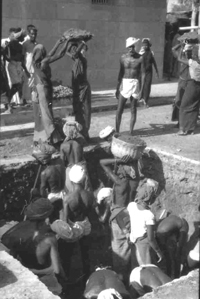
People digging the grave, image 2
I took the next morning pix of the people digging the grave; there had been a discussion lasting all night between the brother and the different cliques about the place where the B. should be buried. The grave digging started late, and the funeral got late, and to my great distress instead of being at 2 pm as planned it got to be only at 6 pm, and no flash could catch the frenzy of the scenes. Just bad luck.
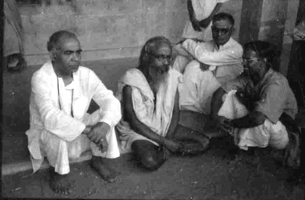
Swami Mouni, image 3
Being a realized soul, B. was going to be buried and not cremated. I took pix of Swami Mouni, one of the secretaries. He used to be a lawyer. He made then the vow of silence; now he is still begs at night for his food, he has a long beard adjoining his hair and a big cloth around his shoulders.
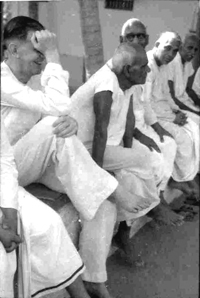
Major Chadwick, image 4
Major Chadwick and other disciples were chatting sitting
on the wall by the side of the room of the B.
He tried all the time to hide from my camera.

Yogi Ramiah, image 5
And another row of disciples with a well-known saintly person second to the left and quite dark skin: Yogi Ramaiah.
Letters and Comments
Invent our own world view
Is it really necessary to analyze in terms of ego, attachment, surrender, atman and Brahman, etc. Does it really matter what we believe, so long as the beauty of our ideals attracts us? Might we just invent our own world view if it seems more natural and authentic?
Whatever the world view is, it is a product of our own invention. For example, if we experience peace and beauty within, we will see the same without. Certainly, we should slowly gravitate towards what is "natural and authentic" and leave behind what is unnatural and deceptive. To analyze and determine what is "authentic" or real, from what is false or unreal, is the proper use of our intellects.
There may be beauty in our ideals and this may attract us. But for these ideals to become a living experience a heroic effort is required, for most aspirants. One should never give up the effort and rest in the comfort of an ideal, however beautiful it may be.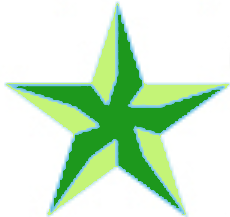






Making external changes
If I could ask a question: Inner self-attention, it seems, doesn't need any particular set of circumstances, but what do you feel is the correct attitude toward making external changes in ones life?
Does prarabdha karma just move easily along, or do you think what feels like a move by 'me' is called for?
My life is quite open right now. There is sometimes a restlessness to want to be part of a setting somehow, as opposed to my quite-alone way right now. Then, though, there is often great gratitude for such opportunity for solitude.Sri Ramana Maharshi's teachings, relating to the decisions we make in life that affect our outer circumstances is very clear, yet incomprehensible to most people.
He says that all the activities we are destined to undertake in this life are already programmed, as it were, and we have no freedom to accept or reject them.
By this, it seems that when we fall out of our mother's womb the book of our life falls out with us and we have no choice but to act in accordance with the script written on each page.
But the Maharshi goes on to say, "Everything is predetermined. But a man is always free not to identify himself with the body and not to be affected by the pleasures or pains consequent on the body's activities."
.Not to identify. with the body is the only recourse or freedom we have, he says. Not many can accept this statement. It just sounds so fatalistic on the surface.
But let us say that we do choose not to identify with the body, we detach ourselves from its activities and cease to identify with the mental activities also. Will the body drop dead? Not likely. Our activities will go on, according to the script written by the Author of the Universe. And, amidst the activity or inactivity, we will be free, resting in peace and eternal happiness.
So, to your question, "Does prarabdha karma just move easily along.?. I would say, .Yes, certainly." The trick is not to identify with it, or attempt to direct it. Our self-asserting will only produce internal conflict.
In practical terms, for the sadhaka, it is best just to attend wholly to what presents itself to us right now and forget all past and future. We must trust in our Guru or God. He will do what is best for us.






Was he not Effulgent?
I read the May/June 2008 issue, and now have two questions. It is noted that someone asked the Maharshi why he was not tejomayam, which is translated as effulgent. Is Maharshi saying that he was not effulgent? I thought he pretty much was, which is what people felt around him, his effulgence. So, is he saying he didn't have effulgence?
Maharshi says that one could concentrate on the saktistana, translated as power-seat, and could develop this effulgence, but he never felt like it. I have never heard of saktistana. Is that a chakra? If so, where is it? I am unclear about this whole thing, as it is clear he had effulgence. Then, mention is made of the shadadhara, which I also have never heard of, and someone asks where it is. What is that and where?
In light of my earlier question about the cow's enlightenment, I read a piece someone posted on the web that said that we need to accept that Maharshi was a son of India and that he accepted some of the milieu, perhaps uncritically. He accepted certain mythologies. It's clear that it flies in the face of reason that a cow could attain enlightenment, what to say about the crow. We may have to face that even Ramana had his limitations in terms of his culture. He must not have seen everything clearly, even if he saw the Truth. It seems that you can see and be the Truth and still be wrong?! I would rather see him as perfect, but I have to admit, it seems he believed certain Indian myths. Otherwise you have to explain how a dog, cow and crow could attain self-realization, without having much in the way of selfhood to overcome.By saying 'tejomayam' the questioner was asking why the Maharshi is still in a bodily form although Self-realized. He erronously believed that a realized being merges in light and becomes disembodied at the moment of realization. Bhagavan was trying to correct his understanding of this point.
He also never went in for mystifying or supernatural spiritual powers which you can learn about in Raja Yoga, Kundalini Yoga, Shakti Marga and other schools.
About the cow's liberation, unless we are at a level of spiritual experience equal to that of Ramana Maharshi, it is not possible to discern what the Maharshi took as truth or as not truth. What may fly in the face of our reason may be a clearly experienced truth to the enlightened. The influence of Indian culture was certainly expressed in the Maharshi's actions and beliefs, just as the influence of our American culture is expressed in our ways of thinking and living. But those beliefs, especially in the Maharshi's case, cannot be assumed erroneous by an onlooker who sees the world only through the adjunct of a mind and not through the omniscient vision of the Universal Self.
What may appear irrational to us, may be experienced as a living truth to a Sage. Mind is not the true measurer of truth. Consciousness freed from mind is.

